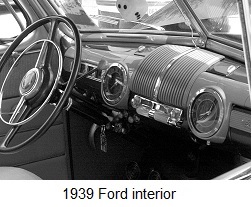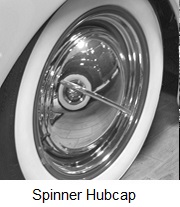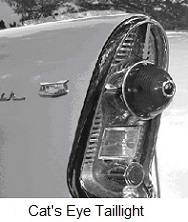
REPRINTS

 We're talking 1954, that's when cruising Main Street began for me. Unless there was a death in the family I
knew where I would be on Thursday night. You could cruise Main at other times, but it just wasn't the same.
Thursday nights were like Yankee Stadium during the World Series versus the regular season. I was a junior in
high school and had recently tapped my tobacco-picking savings for seventy-five bucks to become the proud owner
of a 1937 Plymouth, four-door sedan. The ultimate car in my estimation was a 1936 through a 1940 Ford coupe. It
could be black or that nice deep maroon that Ford was spraying back in those days. If it were maroon you had
your work cut out for you. Back then, maroon would oxidize something terrible. "Clear coat" hadn't been invented.
You spent half your life with your hands in a can of polishing compound and Simonize to give your "bomb" that
"cherry" appearance.
We're talking 1954, that's when cruising Main Street began for me. Unless there was a death in the family I
knew where I would be on Thursday night. You could cruise Main at other times, but it just wasn't the same.
Thursday nights were like Yankee Stadium during the World Series versus the regular season. I was a junior in
high school and had recently tapped my tobacco-picking savings for seventy-five bucks to become the proud owner
of a 1937 Plymouth, four-door sedan. The ultimate car in my estimation was a 1936 through a 1940 Ford coupe. It
could be black or that nice deep maroon that Ford was spraying back in those days. If it were maroon you had
your work cut out for you. Back then, maroon would oxidize something terrible. "Clear coat" hadn't been invented.
You spent half your life with your hands in a can of polishing compound and Simonize to give your "bomb" that
"cherry" appearance.
Once you got it to look presentable, priority two was to have it sound "tough". Your next item to budget was
a glass-packed muffler. If your car couldn't "back off" you just weren't cutting it. In order to execute a
proper back off when cruising Main you had to be running in the lower two gears. Gotta' get your engine revved
to about 2000 rpm's, then draw your foot off the pedal, man. It began with a slight rumble like when you are
gargling, then soon developed into a loud pop, pop like when pop corn begins to blossom. The intention was to
turn heads.
"Sleepers" were a rather inexpensive accessory. Care to venture a guess as to what they were? Sleepers were
a hold-over from the days of World War II when cars were required to cover the top half of the headlights to
hide them from view of enemy airplanes, in case we were attacked by the Germans. By 1950 sleepers were no longer
paint on the headlights they were chromed half circles that snapped under the dress ring that retained the
headlights in their housing. �For five bucks you could get sleepers with a 3/8-inch diameter plastic rod that
had a bright yellow bullet-shaped top. The bottom of the plastic rod was cut at a 45-degree angle. The rod was
fastened perpendicular to the headlight or vertical, on the sleeper's edge and when the light's rays struck the
beveled rod, light was sent up the rod illuminating the yellow tip. There's not many sights in the night that
will surpass this, believe you me.
 "Baby Moons" and "Full Moons" cost a bit more than sleepers. Baby Moons were a smaller version of Full
Moons. If you guessed that they were upgraded replacements for standard manufactured hubcaps, give yourself a
slap on the back. They came in one flavor, Chrome.
"Baby Moons" and "Full Moons" cost a bit more than sleepers. Baby Moons were a smaller version of Full
Moons. If you guessed that they were upgraded replacements for standard manufactured hubcaps, give yourself a
slap on the back. They came in one flavor, Chrome.
The ultimate in wheel-ware was the "Spinner Hub". It was similar to the Baby and Full Moons, except that it
featured a single decorative bar that broke out of the spherical shape of the cap and ran nearly to the edge of
the cap. Spinners enhanced the cap by giving you the feeling of motion. Spinners were the coolest of hubcaps.
 Cat's Eye taillights were used as rear enhancers. They were replacements for standard factory taillight
lenses. What made them cool? They had a blue lens embedded in the normal red taillight. The blue lens was
situated in line with the brake light bulb. When you applied brakes a really cool blue light radiated outward.
So now you looked cool both coming and going.
Cat's Eye taillights were used as rear enhancers. They were replacements for standard factory taillight
lenses. What made them cool? They had a blue lens embedded in the normal red taillight. The blue lens was
situated in line with the brake light bulb. When you applied brakes a really cool blue light radiated outward.
So now you looked cool both coming and going.
Of course, it was also cool to "burn rubber," "peel your tires," or "lay a strip," terms referring to a fast
take-off, so fast that rubber from your tires would be left on the road. This was an urge most young male
drivers couldn't resist. However, the noise and commotion were frowned on by Newt Taggart and other officers of
the law. Sometimes we would get a talking-to a few days later. Officer Taggart would approach you with a
pleasant smile and ask that you be a better citizen.
It never dawned on me back then, but now in retrospect I realize we were the cause of Manchester's biggest
traffic jam every Thursday night. On a slow night, that is a night when no one shouted your name and beckoned
you to the curb to chat and act cute with our girl classmates, you might make the trip from the center terminus
to the Charter Oak terminus 5 times. That's 10 miles total around the circuit. The preferred route from Hartford
to Providence was still Route 44 back then. Can you imagine the congestion caused at the center terminus by our
steady flow of kids in their cool cars?�
Cruising came to an end as suddenly as a senior citizen's hot dog roast. At five minutes before 9 p.m.,
everything was normal and then Main Street went dark. You could fire a cannon down Main Street without fear of
injuring anyone. See you next Thursday night 'round 7.
Dick Jenkins graduated from Manchester High School in 1955. For years he maintained a web site with pictures and stories of old-time Manchester. After he retired from webmaster work, Dick graciously agreed to turn over those pages to the Manchester Historical Society; msny of which have been reproduced in this "Reprints" section of this web site. You can access them by clicking REPRODUCED mhs1955.com PAGES. Dick now lives in Florida with his wife, Sandy.